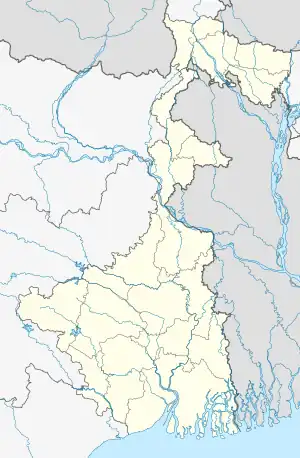Tilpi | |
|---|---|
Village | |
 Terracotta Plaque Found at Dhosa/Tilpi, Now at State Archaeological Museum at Behala | |
 Tilpi Location in West Bengal  Tilpi Location in India | |
| Coordinates: 22°14′17″N 88°33′41″E / 22.2380°N 88.5614°E | |
| Country | |
| State | |
| District | South 24 Parganas |
| CD block | Jaynagar I |
| Area | |
| • Total | 7.94 km2 (3.07 sq mi) |
| Elevation | 8 m (26 ft) |
| Population (2011) | |
| • Total | 13,350 |
| • Density | 1,700/km2 (4,400/sq mi) |
| Languages | |
| • Official | Bengali[1][2] |
| • Additional official | English[1] |
| Time zone | UTC+5:30 (IST) |
| PIN | 743337 |
| Telephone code | +91 3218 |
| Vehicle registration | WB-19 to WB-22, WB-95 to WB-99 |
| Lok Sabha constituency | Jadavpur |
| Vidhan Sabha constituency | Baruipur Purba (SC) |
| Website | www |
Tilpi is a village and an archaeological site within the jurisdiction of the Jaynagar Majilpur police station in the Jaynagar I CD block in the Baruipur subdivision of the South 24 Parganas district in the Indian state of West Bengal.
History
According to the District Census Handbook, this archeological site is located beside the Piyali river. “Here, beside different artefacts, remains of some ancient structures have also been discovered. Sunga style Terracotta artefacts, earthen wares with ornate design, toy carts with animals like elephant, ram, god-like figurines etc. have been excavated. The most notable item of Tilpi is a mould of elephant decorated with flower at the end of the trunk.” It was excavated in 2005–07.[3]
According to Sharmi Chakraborty, Centre for archaeological Studies and Training, Eastern India, the site was excavated by the Directorate of Archaeology and Museums. “ Period I is dated to 2nd/1st century BC E Period III 2nd/3rd century CE.” Among the artefacts recovered were: “terracotta plaques, pottery, uninscribed cast-copper coins, semi-precious stone beads.”[4]
Geography
M: municipal city/ town, CT: census town, R: rural/ urban centre, N: neighbourhood, H: historical place/ religious centre
Places linked with coastal activity are marked in blue
Owing to space constraints in the small map, the actual locations in a larger map may vary slightly
Area overview
Baruipur subdivision is a rural subdivision with moderate levels of urbanization. 31.05% of the population lives in the urban areas and 68.95% lives in the rural areas. In the southern portion of the subdivision (shown in the map alongside) there are 20 census towns. The entire district is situated in the Ganges Delta and the southern part is covered by the Baruipur-Jaynagar Plain.[5][6][7]
Note: The map alongside presents some of the notable locations in the subdivision. All places marked in the map are linked in the larger full screen map.
Location
Tilpi is located at 22°14′17″N 88°33′41″E / 22.2380°N 88.5614°E. It has an average elevation of 8 metres (26 ft).
Demographics
According to the 2011 Census of India, Tilpi had a total population of 13,350, of which 6,853 (51%) were males and 6,507 (49%) were females. There were 2,635 persons in the age range of 0 to 6 years. The total number of literate persons in Tilpi was 7,011 (65.43% of the population over 6 years).[8]
Transport
Gocharan-Dhosa Road links Tilpi to the State Highway 1.[9]
Gocharan railway station is located nearby.[9]
Healthcare
Padmerhat Rural Hospital, with 30 beds, at Padmerhat, is the major government medical facility in the Jaynagar I CD block.[10]
References
- 1 2 "Fact and Figures". Wb.gov.in. Retrieved 5 July 2019.
- ↑ "52nd REPORT OF THE COMMISSIONER FOR LINGUISTIC MINORITIES IN INDIA" (PDF). Nclm.nic.in. Ministry of Minority Affairs. p. 85. Archived from the original (PDF) on 25 May 2017. Retrieved 5 July 2019.
- ↑ "District Census Handbook South Twentyfour Parganas, Census of India 2011, Series 20, Part XII A" (PDF). Pages 134-135: Places of Archaeological Importance. Directorate of Census Operations, West Bengal. Retrieved 3 January 2020.
- ↑ Chakraborty, Sharmi. "Archaeological Sites of Lower Deltaic Region of West Bengal and Their Context: Some Preliminary Observations". Academia.edu. Retrieved 3 January 2020.
- ↑ "District Statistical Handbook 2014 South Twety-four Parganas". Table 2.1 , 2.2, 2.4b. Department of Statistics and Programme Implementation, Government of West Bengal. Retrieved 5 December 2019.
- ↑ "Census of India 2011, West Bengal, District Census Handbook, South Twentyfour Parganas, Series – 20, Part XII-A, Village and Town Directory" (PDF). Page 13, Physiography. Directorate of Census Operations, West Bengal. Retrieved 5 December 2019.
- ↑ "District Human Development Report: South 24 Parganas". Chapter 9: Sundarbans and the Remote Islanders, p 290-311. Development & Planning Department, Government of West Bengal, 2009. Archived from the original on 5 October 2016. Retrieved 5 December 2019.
- ↑ "C.D. Block Wise Primary Census Abstract Data(PCA)". West Bengal – District-wise CD Blocks. Registrar General and Census Commissioner, India. Retrieved 3 January 2020.
- 1 2 Google maps
- ↑ "Health & Family Welfare Department" (PDF). Health Statistics – Rural Hospitals. Government of West Bengal. Retrieved 29 November 2019.